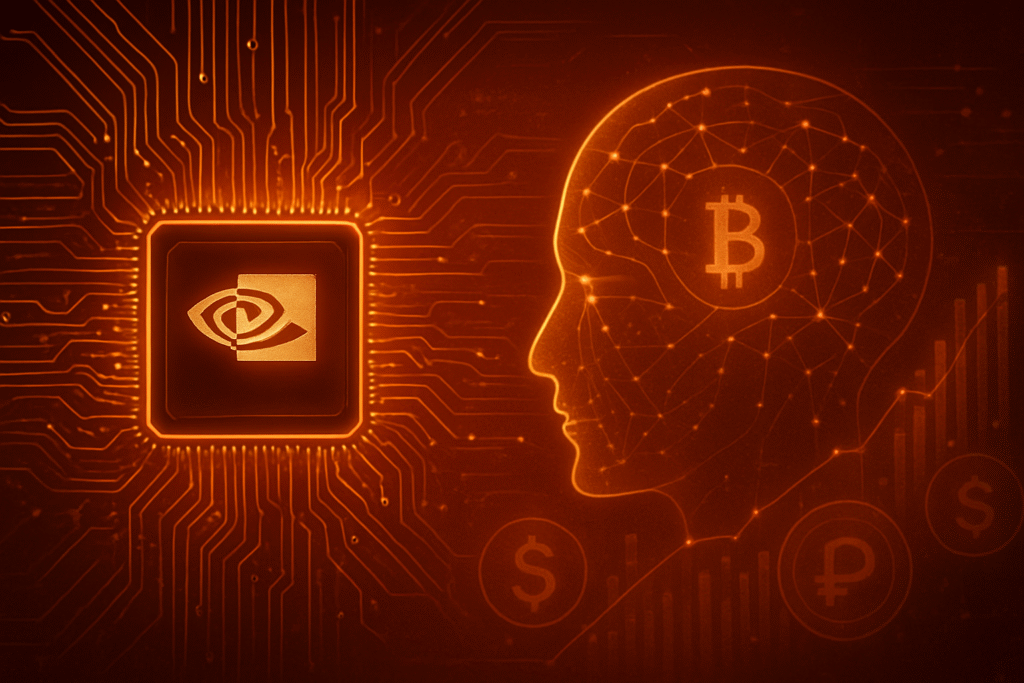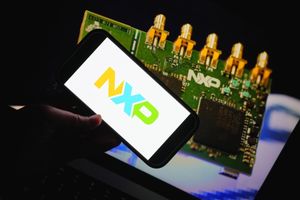
October 28, 2025 – In the volatile landscape of digital assets, a surprising contender has emerged as a potentially "safer" investment avenue for those seeking exposure to the cryptocurrency ecosystem: Nvidia (NASDAQ: NVDA). The chipmaking giant, renowned for its cutting-edge Graphics Processing Units (GPUs), has cemented its role as the foundational technology provider for both the artificial intelligence (AI) revolution and, increasingly, the burgeoning field of AI in blockchain infrastructure. This unique positioning has led to growing market sentiment that investing in Nvidia offers a diversified, albeit indirect, way to participate in the crypto space without grappling with the extreme price swings of individual digital currencies.
This shift in perception is not merely a fleeting trend but a reflection of the deep integration of AI into Web3. As of late 2025, Nvidia's hardware underpins everything from decentralized AI networks and intelligent smart contracts to tokenized compute marketplaces, fundamentally impacting the efficiency, security, and scalability of blockchain technologies. The immediate market reaction to this thesis has been a strengthening of Nvidia's appeal among institutional investors and traditional tech funds, who view it as a robust play on the underlying technological trends driving crypto innovation. For the broader crypto ecosystem, Nvidia's dominance signifies a critical reliance on high-performance computing, highlighting the indispensable hardware layer that powers the decentralized future.
Market Impact and Price Action
Historically, Nvidia's stock performance has exhibited a notable correlation with major cryptocurrency cycles, particularly during periods of intense GPU mining demand. The Bitcoin bull run between 2015 and 2017, for instance, coincided with a significant surge in Nvidia's stock and sales as miners flocked to acquire its powerful GPUs. This positive correlation, at times reaching as high as 0.80 between Nvidia and Bitcoin in late 2024 and early 2025, reflected a broader "risk-on" environment where both speculative tech stocks and digital assets thrived. Nvidia's financial results, especially its data center chip revenue, often acted as a bellwether, influencing confidence in the broader AI and crypto sectors.
However, as of mid-2025, this direct correlation has shown signs of evolving, with a noticeable decoupling. Recent data indicated the 90-day correlation between Bitcoin and Nvidia falling below 0.3, occasionally even registering near-zero or negative readings. This suggests that while Nvidia's influence remains, crypto-specific events and broader macroeconomic factors are increasingly driving digital asset prices independently. Despite this, Nvidia's robust financial performance continues to indirectly impact crypto market sentiment. For example, strong data center chip revenue in Nvidia's Q1 2025 earnings report provided a significant boost to AI-related tokens like Render Network (RNDR), Fetch.ai (FET), and Ocean Protocol (OCEAN), which saw substantial daily gains in anticipation and aftermath of the report. Conversely, market concerns about open-source AI models potentially reducing demand for high-end chips led to a 17% drop in Nvidia's stock in January 2025, dragging down Bitcoin and several AI tokens in its wake, underscoring the interconnectedness.
The investment appeal of Nvidia (NASDAQ: NVDA) as an indirect crypto play is further bolstered by its strong underlying business fundamentals. The company's market capitalization surpassed $4 trillion in July 2025, driven by surging demand for its AI supercomputers like the Blackwell series, which reported billions in sales in its first quarter alone. This massive institutional interest in Nvidia, often through tech-focused funds, creates a dynamic where its performance can influence broader crypto market sentiment and institutional money flows into digital assets. Some analysts have even raised concerns about a "double bubble" scenario, linking the speculative rises of both AI and crypto, implying that a slowdown in the AI boom could impact Bitcoin due to their growing correlation. Nevertheless, for investors seeking exposure to the technological backbone of the decentralized future, Nvidia offers a less volatile and more diversified alternative to direct cryptocurrency investments.
Community and Ecosystem Response
Within the crypto community, discussions around Nvidia have evolved significantly from the early days of GPU mining. While the company's GPUs are still utilized for mining certain ASIC-resistant altcoins like Ethereum Classic (ETC), the primary focus has shifted to Nvidia's role in powering decentralized AI and Web3 infrastructure. Social media sentiment across platforms like Crypto Twitter and Reddit often highlights Nvidia as the "picks and shovels" provider for the AI revolution, which is increasingly intertwined with blockchain. Influencers and thought leaders frequently emphasize the synergy between AI and blockchain, positioning Nvidia as an indispensable enabler.
Projects across the decentralized finance (DeFi) and Web3 spectrum are actively leveraging Nvidia's technology. Decentralized compute networks like Akash Network are tokenizing computing power, with Nvidia's Blackwell GPU clusters propelling these markets into enterprise-level domains. This allows AI models to train, manage resources, and conduct transactions using on-chain financial mechanisms. Furthermore, initiatives like OceanPal's SovereignAI subsidiary, which is developing a confidential AI cloud platform "powered by NEAR (NEAR) and Nvidia technologies" with backing from the NEAR Foundation and crypto-native investors, exemplify the direct integration of Nvidia's hardware into cutting-edge blockchain solutions for privacy-first AI.
The broader sentiment within the ecosystem recognizes that AI agents and smart contracts, now seen as the next evolutionary stage beyond traditional smart contracts, are heavily reliant on powerful computational resources. Nvidia's Nemotron and Cosmos models, enabling on-chain AI agents with physical world action capabilities, are viewed as critical advancements. This makes Nvidia not just a hardware provider but a key partner in the development of more intelligent, autonomous, and decentralized applications, fostering a sense of reliance and optimism within the developer community for future innovations built upon its technology.
What's Next for Crypto
The deepening convergence of AI and blockchain, heavily reliant on Nvidia's (NASDAQ: NVDA) hardware, portends significant short and long-term implications for the crypto market. In the short term, continued strong performance from Nvidia, particularly in its data center and AI segments, will likely sustain investor confidence in AI-related crypto tokens and projects. These tokens, such as those from Render Network (RNDR), Fetch.ai (FET), and Ocean Protocol (OCEAN), derive their utility from powering AI computations and incentivizing data contributions, making them direct beneficiaries of Nvidia's advancements. Any major product announcements or positive earnings reports from Nvidia could act as immediate catalysts, driving renewed interest and capital into this niche.
Looking further ahead, the long-term implications are transformative. The ongoing development of decentralized AI networks, AI-optimized smart contracts, and autonomous AI agents operating on the blockchain will fundamentally reshape how Web3 applications function. Nvidia's role as the primary provider of the underlying computational infrastructure means that its technological roadmap will directly influence the pace and direction of innovation in these areas. Strategic considerations for crypto projects and investors will increasingly revolve around identifying and supporting protocols that effectively integrate AI, leveraging high-performance computing, and building robust, scalable decentralized AI solutions. This could lead to a new wave of crypto projects focused on AI-as-a-service, decentralized machine learning, and AI-driven data marketplaces.
Potential scenarios include the emergence of entirely new asset classes driven by AI utility, where tokens represent access to decentralized compute, AI models, or verified datasets. The increased efficiency and intelligence brought by AI to blockchain operations could also drive broader enterprise adoption of Web3 technologies, as AI algorithms can analyze distributed data for more tamper-proof outcomes and optimize smart contract execution, leading to significant efficiency gains (e.g., reported 300% increase in transaction efficiency). The likelihood of these scenarios materializing is high, given the current trajectory of technological advancement and the increasing capital flowing into the AI and blockchain intersection.
Bottom Line
For crypto investors and enthusiasts, the key takeaway is that Nvidia (NASDAQ: NVDA) represents a unique and compelling way to gain exposure to the underlying technological revolution driving the digital asset space. While not a direct cryptocurrency investment, its role as the undisputed leader in AI hardware makes it an indispensable component of the decentralized future. Investing in Nvidia is akin to investing in the "picks and shovels" of the AI and blockchain gold rush, offering a more diversified and potentially less volatile path compared to direct crypto holdings.
The long-term significance of Nvidia's position lies in its foundational role. As AI and blockchain continue their deep integration, Nvidia's technology will remain critical for powering everything from decentralized AI agents and secure data marketplaces to advanced Web3 applications. This means its performance will continue to be a significant indicator for the health and growth of the AI-driven crypto sector, influencing sentiment and investment flows.
Final thoughts on what this means for crypto adoption point towards a future where AI and blockchain are inextricably linked. The advancements enabled by Nvidia's hardware will contribute to more intelligent, efficient, and user-friendly decentralized systems, potentially accelerating mainstream adoption of Web3 technologies. Important dates and metrics to monitor include Nvidia's quarterly earnings reports, announcements from major AI and blockchain conferences (e.g., GTC, ETHDenver), and the performance of key AI-related crypto tokens like RNDR, FET, and OCEAN, which often react strongly to Nvidia-related news. The continued demand for high-performance computing, driven by both AI and evolving blockchain needs, solidifies Nvidia's position as a critical player in the ongoing digital revolution.
This article is for informational purposes only and does not constitute financial or investment advice. Cryptocurrency investments carry significant risk.






